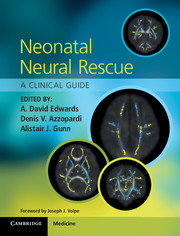Book contents
- Frontmatter
- Contents
- List of contributors
- Foreword
- Section 1 Scientific background
- Section 2 Clinical neural rescue
- 6 Challenges for parents and clinicians discussing neuroprotective treatments
- 7 The pharmacology of hypothermia
- 8 Selection of infants for hypothermic neural rescue
- 9 Hypothermia during patient transport
- 10 Whole body cooling for therapeutic hypothermia
- 11 Selective head cooling
- 12 Hypothermic neural rescue for neonatal encephalopathy in mid- and low-resource settings
- 13 Cerebral function monitoring and EEG
- 14 Magnetic resonance imaging in hypoxic–ischaemic encephalopathy and the effects of hypothermia
- 15 Novel uses of hypothermia
- 16 Neurological follow-up of infants treated with hypothermia
- 17 Registry surveillance after neuroprotective treatment
- Section 3 The future
- Index
- References
14 - Magnetic resonance imaging in hypoxic–ischaemic encephalopathy and the effects of hypothermia
from Section 2 - Clinical neural rescue
Published online by Cambridge University Press: 05 March 2013
- Frontmatter
- Contents
- List of contributors
- Foreword
- Section 1 Scientific background
- Section 2 Clinical neural rescue
- 6 Challenges for parents and clinicians discussing neuroprotective treatments
- 7 The pharmacology of hypothermia
- 8 Selection of infants for hypothermic neural rescue
- 9 Hypothermia during patient transport
- 10 Whole body cooling for therapeutic hypothermia
- 11 Selective head cooling
- 12 Hypothermic neural rescue for neonatal encephalopathy in mid- and low-resource settings
- 13 Cerebral function monitoring and EEG
- 14 Magnetic resonance imaging in hypoxic–ischaemic encephalopathy and the effects of hypothermia
- 15 Novel uses of hypothermia
- 16 Neurological follow-up of infants treated with hypothermia
- 17 Registry surveillance after neuroprotective treatment
- Section 3 The future
- Index
- References
Summary
Introduction
Magnetic resonance (MR) imaging is an ideal tool to assess the neonatal brain following a hypoxic–ischaemic event, providing complementary information to cranial ultrasound. It can identify alternative or additional diagnoses such as congenital malformations or antenatal injury and an optimal examination allows the timing, the site and severity of perinatally acquired injury to be determined. This in turn may be used to predict neurodevelopmental outcome for the majority of neonates. The provision of diagnostic and prognostic information is, however, often hampered by poor image quality, inappropriately timed examinations and inaccurate interpretation of the scans. Image quality may be impaired by motion artefact, poor signal to noise ratio or inappropriate sequence choice.
In the new era of interventions, such as hypothermia, designed to prevent or modify perinatally acquired brain injury it is necessary to determine whether imaging practice needs to be altered during or following therapy to ensure it fulfils its potential as a diagnostic and prognostic tool. Hypothermia has become standard of care in the neonate with hypoxic–ischaemic encephalopathy (HIE) and the demand for MR examination of the neonatal brain to predict prognosis is increasing rapidly. In parallel with its clinical role, MRI is able to assess the neurobiological effects of a new intervention, providing surrogate data for later outcomes and thereby avoiding the delays inherent in long-term follow-up studies [1–3].
- Type
- Chapter
- Information
- Neonatal Neural RescueA Clinical Guide, pp. 153 - 165Publisher: Cambridge University PressPrint publication year: 2013

